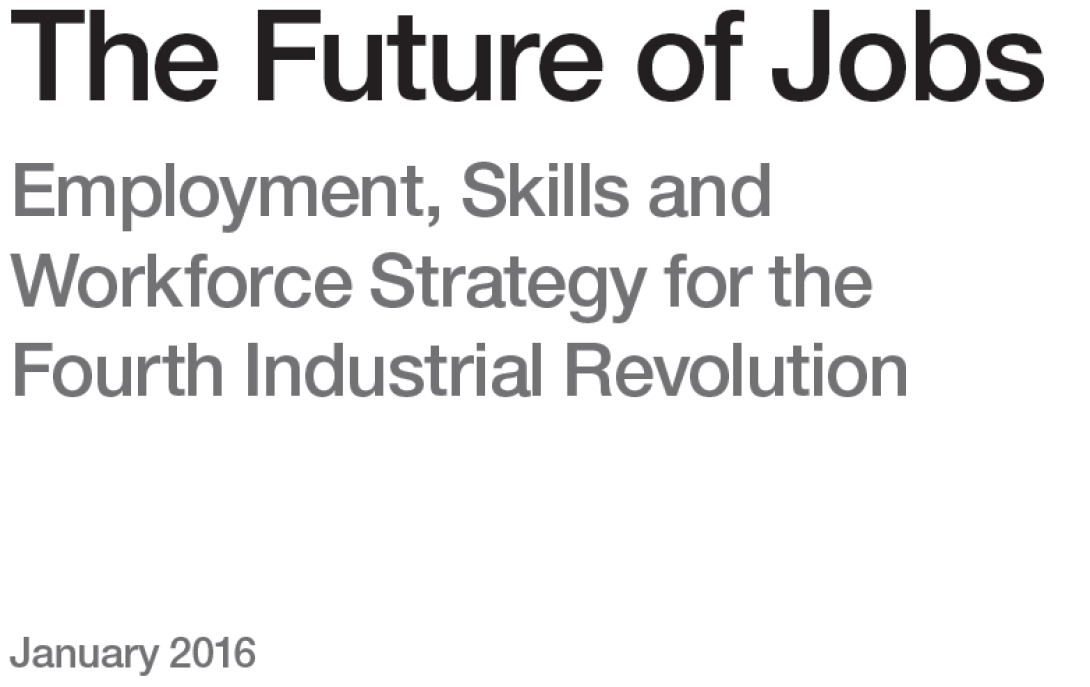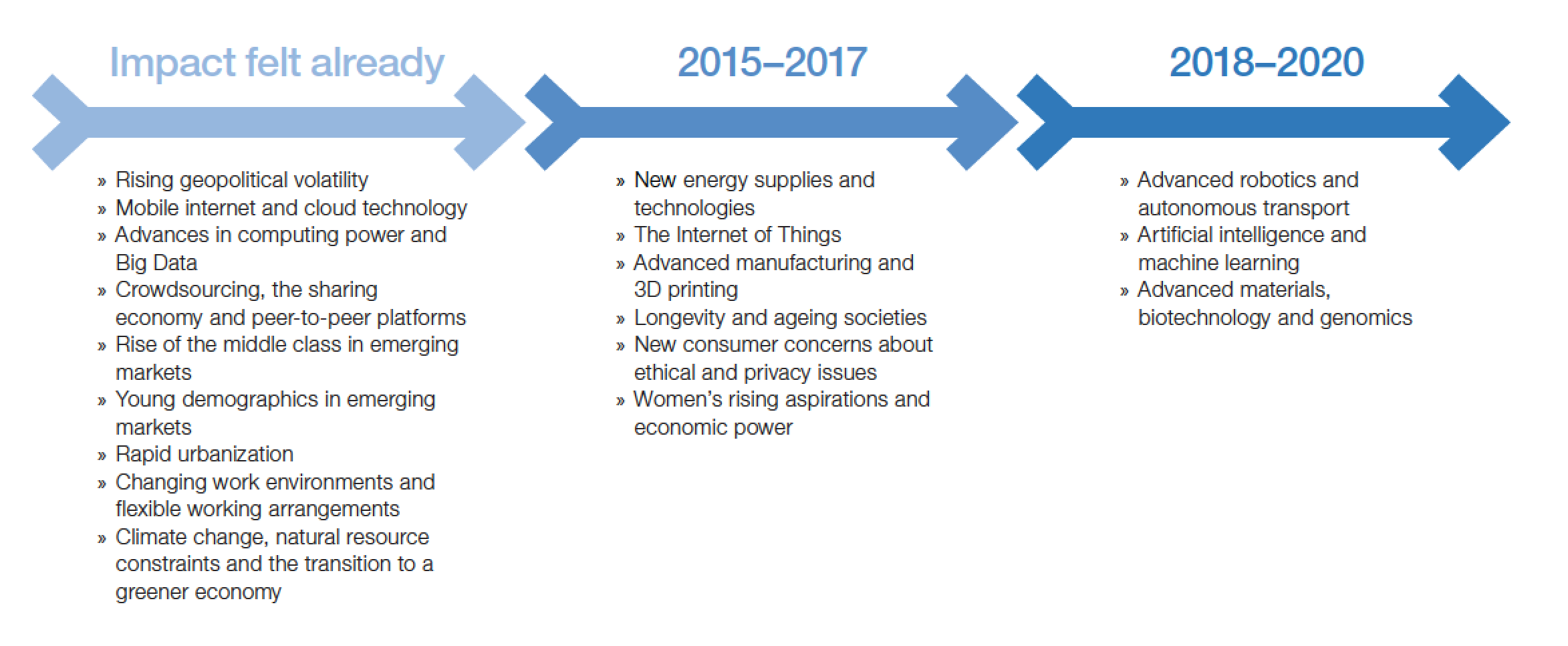
Event Report: The Future Of Jobs From #Davos16 #WEF

Will We Move Beyond Man Vs Machine In The Fourth Industrial Revolution?
The World Economic Forum released it's Future of Jobs report. As expected, the business model disruption across technology, societal, and economic forces have created urgency to understand the jobs and skills required for the next decade. The survey and research design relied on interviews with global CHROs and other senior talent and strategy executives that impacted over 13,549,000 employees.
20160118 Future of Jobs Report Analysis #WEFTalks from Constellation Research on Vimeo.
Inside The Drivers Of Change
The confluence of new technologies, demographics, and socioeconomic shifts have created an impact in how jobs will be created and what skill sets will be required. Success in the future of jobs may require a recalcuation in
The top five drivers of demographic and socioeconomic drivers of change include
- Changing work environments and flexible working arrangements (44%)
- Rise of the middle class in emerging markets (23%)
- Climate change, natural resource constraints and the transition to a greener economy (23%)
- Rising geopolitical volatility (21%)
- New consumer concerns about ethical and privacy issues (16%)
The top five technological drivers of change include:
- Mobile internet and cloud technology (34%)
- Advances in computing power and big data (26%)
- New energy supplies and technology (22%)
- The internet of things (14%)
- Crowdsourcing, the sharing economy and P2P platforms (12%)
Figure 1. Time Frame to Impact Industries and Business Models

Source: World Economic Forum
The Bottom Line: Drivers Of Change Hint At Larger Systemic Forces Impacting The Labor Market
The confluence of new technologies, demographics, and socioeconomic shifts have created an impact in how jobs will be created and what skill sets will be required. Success in the future of jobs may require a new perspective on how growth should be calculated. What if growth was measured by per capita? The result would show the benefits of a decreasing population abetted by automation, robotics, and AI with a better quality of life.
Your POV.
Where do you see the future of jobs? Should we aim for decreasing populations to improve quality per capita? What are your questions from the report?
Add your comments to the blog or reach me via email: R (at) ConstellationR (dot) com or R (at) SoftwareInsider (dot) org.
- Developing your digital business strategy
- Connecting with other pioneers
- Sharing best practices
- Vendor selection
- Implementation partner selection
- Providing contract negotiations and software licensing support
- Demystifying software licensing
Resources
- Event Report: The @Wipro @FT Dinner, Man vs Machine, Does It Have To Be Either/Or? #Davos2016 #WEF #WEFTalks
- Event Report: The Weekend Before Davos And The Dawn Of The Fourth Industrial Revolution
- News Analysis: In Search Of Growth Amidst Digital Disruption
- Monday’s Musings: Who Gets To Be A Chief Digital Officer?
- Monday’s Musings: The Seven Rules For Digital Business And Digital Transformation
- Tuesday’s Tip: Five Steps To Starting Your Digital Transformation Initiative
- Monday’s Musings: What Organizations Want From Mobile
- Research Summary: Economic Trends Exacerbate Digital Business Disruption And Digital Transformation (The Futurist Framework Part 3)
- Research Summary: Five Societal Shifts Showcase The Digital Divide Ahead (The Futurist Framework Part 2)
- Research Summary: Sneak Peaks From Constellation’s Futurist Framework And 2014 Outlook On Digital Disruption
- Research Report: Digital ARTISANs – The Seven Building Blocks Behind Building A Digital Business DNA
- Research Summary: Five Societal Shifts Showcase The Digital Divide Ahead (The Futurist Framework Part 2)
- Research Summary: Next Generation CIOs Aspire To Focus More On Innovation And The Chief Digital Officer Role
- Trends: [VIDEO] The Digital Business Disruption Ahead Preview – NASSCOM India Leadership Forum (#NASSCOM_ILF)
- News Analysis: New #IBMWatson Business Group Heralds The Commercialization Of Cognitive Computing. Ready For Augmented Humanity?
- Harvard Business Review: What a Big Data Business Model Looks Like
- Monday’s Musings: How The Five Consumer Tech Macro Pillars Influence Enterprise Software Innovation
- Tuesday’s Tip: Understand The Five Generation Of Digital Workers And Customers
- Monday’s Musings: The Chief Digital Officer In The Age Of Digital Business
- Slide Share: The CMO vs CIO – Pathways To Collaboration
- Event Report: CRM Evolution 2013 – Seven Trends In The Return To Digital Business And Customer Centricity
- News Analysis: Sitecore Acquires Commerce Server In Quest Towards Customer Experience Management
- News Analysis: Salesforce 1 Signals Support For Digital Business at #DF13
- Research Summary And Speaker Notes: The Identity Manifesto – Why Identity Is At The Heart of Digital Business
Reprints
Reprints can be purchased through Constellation Research, Inc. To request official reprints in PDF format, please contact Sales .
Disclosure
Although we work closely with many mega software vendors, we want you to trust us. For the full disclosure policy,stay tuned for the full client list on the Constellation Research website.
* Not responsible for any factual errors or omissions. However, happy to correct any errors upon email receipt.
Copyright © 2001 -2016 R Wang and Insider Associates, LLC All rights reserved.
Contact the Sales team to purchase this report on a a la carte basis or join the Constellation Customer Experience
 R "Ray" Wang
R "Ray" Wang R "Ray" Wang
R "Ray" Wang